
Much has changed in our world in the last 125 years – and higher education has not been immune. When the University of Tulsa was founded as Henry Kendall College just before the turn of the 20th century, the school looked entirely different than it does today, except for one element: dedication to students.
TU’s origins extend to the Presbyterian School for Indian Girls in Muskogee, founded in 1882. The small boarding school, started by the Presbyterian Board of Home Missions, became Henry Kendall College in 1894. The first college classes began that fall. The name honored the first Home Mission Board general secretary.
Kendall College was created to provide a liberal arts education through the study of the Bible, the classics and science. The college offered bachelor of arts and bachelor of science degrees, according TU officials. In 1898, Kendall College graduated three students, who hold the distinction of being the first people to earn bachelor’s degrees in what is now Oklahoma.
The school struggled financially during its first decade, which led officials to ask the Presbyterian synod, the denomination’s leadership body, to take over and find a new location for the school. To the northwest, a booming oil town that needed a college was the perfect fit. In the same year Oklahoma became a state (1907), Kendall College moved to Tulsa – temporarily in the First Presbyterian Church downtown, then to its current site off East 11th Street.
In 1919, a new college with ties to the Southern Methodist Church was proposed for Tulsa; Kendall College trustees recommended the two schools unite under a common name, the University of Tulsa, because the city was not big enough to sustain two competing colleges. According to the TU website, the charter for the University of Tulsa was approved Nov. 9, 1920.
According to the Encyclopedia of Oklahoma History and Culture, TU added its schools of law and business administration in the 1940s. The 1980s brought a focus on transitioning from a commuter campus to a residential university, according to TU officials. The next few decades saw the addition of the Reynolds Center basketball gymnasium, Collins Hall administration building, and additional science, engineering, performing arts and residential facilities.
TU’s focus on students thrives through a dedication to free inquiry, integrity of character and a lifelong pursuit of learning.
“The University of Tulsa has served Oklahoma for 125 years, and will be here to educate students for many future generations,” interim president Janet Levit says. “Our mission – to prepare students for the responsibility of citizenship, service and leadership in a changing world, and to acquire the skills and appetite for lifelong learning – has never been more important.”


























